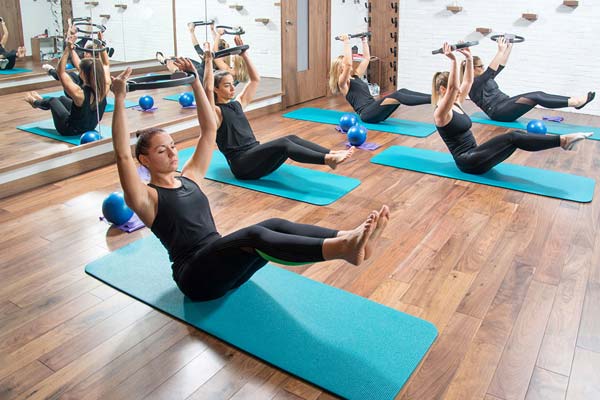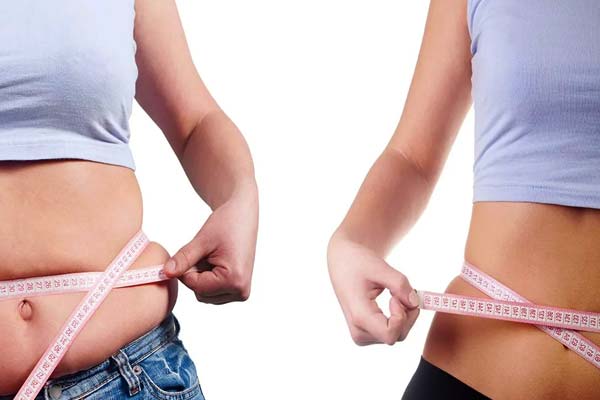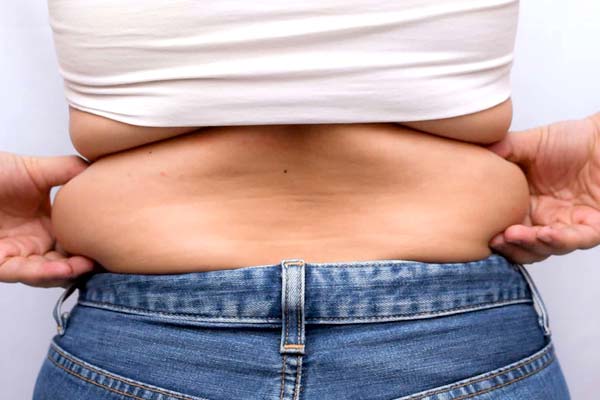البيلاتس والفيبروميالغيا: تخفيف الألم وتحسين اللياقة البدنية
تعاني العديد من الأشخاص من مرض الفيبروميالغيا، والذي يتسبب في الشعور بالألم والتعب الشديد. ولكن يمكن لممارسة التمارين الرياضية المناسبة أن تساعد في تخفيف هذه الأعراض. ومن بين هذه التمارين تمارين البيلاتس، التي تعتبر مناسبة للأشخاص الذين يعانون من الفيبروميالغيا.
تعتمد تمارين البيلاتس على الحركات البطيئة والتركيز على الجزء الأساسي من الجسم. وقد أظهرت الدراسات أن ممارسة التمارين البيلاتس يمكن أن تساعد في تحسين قوة العضلات وتحسين التوازن والمرونة. كما أنها تساعد في تحسين الصحة العامة للجسم، وتقليل الألم والتعب الناتج عن الفيبروميالغيا.
ينصح العديد من الخبراء بممارسة التمارين البيلاتس للأشخاص الذين يعانون من الفيبروميالغيا. ولكن يجب الانتباه إلى أنه يجب تحديد مستوى الجهد المناسب لكل شخص وفقًا لحالته الصحية. وبالتالي، يجب استشارة الطبيب قبل البدء في ممارسة التمارين البيلاتس أو أي تمارين رياضية أخرى.
ما هو متلازمة الألم العضلي الليفي؟
تعد متلازمة الألم العضلي الليفي (Fibromyalgia) حالة صحية مزمنة تتسم بالألم والتعب الشديد والحساسية في بعض المناطق من الجسم. يعاني المصابون بالمتلازمة من ألم عضلي وتعب مستمر يمكن أن يؤثر على الحياة اليومية والنوم والعمل.
تعتبر متلازمة الألم العضلي الليفي حالة معقدة ومتعددة الأسباب، ولا يوجد اختبار محدد لتشخيصها. يعتمد التشخيص على تحديد الأعراض واستبعاد الأسباب الأخرى للألم والتعب.
تشمل الأعراض الشائعة لمتلازمة الألم العضلي الليفي الألم الشديد في العضلات والأربطة والأوتار والمفاصل، والتعب المستمر، والحساسية للمس، والصعوبة في النوم، والصداع، والتشنجات العضلية.
يمكن للأطباء استخدام الأدوية والعلاجات الطبيعية والتمارين الرياضية لعلاج متلازمة الألم العضلي الليفي. يجب على المرضى العمل مع فريق الرعاية الصحية لتحديد العلاج المناسب لحالتهم الفردية.
بشكل عام، يمكن لتمارين البيلاتس أن تكون فعالة في علاج متلازمة الألم العضلي الليفي. تساعد تمارين البيلاتس على تقوية العضلات وتحسين مرونتها، وتحسين التوازن والتنسيق بين الجسم والعقل، وتحسين النوم وتخفيف الألم.
في النهاية، يجب على المرضى العمل مع فريق الرعاية الصحية لتحديد الخيارات العلاجية المناسبة لحالتهم الفردية، والالتزام بالعلاجات والتمارين الموصوفة لتحسين جودة حياتهم.
كيف يؤثر مرض الفيبروميالجيا على الحركة والحياة اليومية؟
يعاني مرضى الفيبروميالجيا من آلام عضلية مزمنة وتعب شديد وعدم انتظام النوم، وهذه الأعراض تؤثر سلبًا على حركتهم وحياتهم اليومية. يمكن أن يتسبب المرض في تقليل القدرة على القيام بالأنشطة اليومية الأساسية، مثل الذهاب للعمل أو القيام بالأعمال المنزلية.
يعاني المرضى أيضًا من تفاقم الأعراض بشكل مفاجئ وغير متوقع، ويشعرون بألم شديد وتعب شديد حتى في الأنشطة البسيطة، مما يجعلهم يشعرون بالإحباط والضعف. يمكن أن يؤثر هذا الإحباط على الحالة النفسية للشخص ويزيد من مستويات القلق والاكتئاب.
يؤثر مرض الفيبروميالجيا أيضًا على نوعية النوم، حيث يعاني المرضى من اضطرابات في النوم وعدم القدرة على النوم بشكل جيد، مما يؤثر على حالتهم الصحية والنفسية. يمكن أن يؤدي النوم السيئ إلى زيادة الألم والتعب وتفاقم الأعراض.
يمكن لممارسة التمارين الرياضية المناسبة، مثل تمارين البيلاتيس، أن تساعد في تحسين حالة المرضى وتخفيف الأعراض. تعمل تمارين البيلاتيس على تقوية العضلات وتحسين المرونة وتحسين التوازن، مما يساعد في تحسين حركة المرضى وتقليل الألم والتعب.
بالإضافة إلى ذلك، يمكن لتمارين البيلاتيس أن تساعد في تحسين جودة النوم وتقليل الإجهاد والتوتر، مما يساعد في تحسين الحالة الصحية العامة والنفسية للمرضى. ومع ذلك، يجب على المرضى استشارة الطبيب قبل بدء أي نوع من التمارين الرياضية للتأكد من أنها مناسبة لحالتهم الصحية.
فوائد البيلاتس لمرض الفيبروميالجيا
يُعدّ البيلاتس تمرينًا شهيرًا يستخدم لتحسين اللياقة البدنية والنفسية، وقد أثبتت الدراسات أنّه يمكن أن يكون فعالًا في تخفيف أعراض مرض الفيبروميالجيا، وهو اضطراب مزمن يتميز بآلام العضلات والتعب والأرق. وفيما يلي بعض الفوائد التي يمكن أن يوفرها البيلاتس لمرضى الفيبروميالجيا:
- تحسين اللياقة البدنية: يمكن أن يساعد البيلاتس في تحسين القوة والمرونة والتوازن البدني، وهذا يمكن أن يساعد في تخفيف الألم والتعب.
- تحسين الجودة الحياتية: يمكن أن يؤدي الألم المستمر إلى تقليل الجودة الحياتية للأشخاص الذين يعانون من مرض الفيبروميالجيا، ويمكن أن يساعد البيلاتس في تحسين الحالة المزاجية والشعور بالراحة.
- تحسين التوازن العاطفي: يمكن أن يساعد البيلاتس في تحسين التركيز والانتباه والتحكم في الضغوط العاطفية، وهذا يمكن أن يساعد في تخفيف الألم والتعب.
- تخفيف الألم والتعب: يمكن أن يساعد البيلاتس في تحسين تدفق الدم وتقليل التوتر العضلي، وهذا يمكن أن يساعد في تخفيف الألم والتعب.
- تحسين النوم: يمكن أن يساعد البيلاتس في تحسين النوم وتقليل الأرق، وهذا يمكن أن يساعد في تحسين الجودة الحياتية.
على الرغم من أن البيلاتس يمكن أن يكون فعالًا في تخفيف أعراض مرض الفيبروميالجيا، إلا أنه يجب على الأشخاص الذين يعانون من هذا المرض التحدث إلى طبيبهم قبل البدء في أي برنامج تمريني جديد.
تمارين البيلاتس
تعتبر تمارين البيلاتس من التمارين المفيدة جداً لمرضى الفيبروميالجيا، حيث تعمل على تقوية عضلات الجسم وتحسين التوازن والتنفس، وهي تمارين ذات تأثير منخفض على المفاصل والعظام مما يجعلها مناسبة للأشخاص الذين يعانون من آلام المفاصل والعظام.
تعمل تمارين البيلاتس على تقوية عضلات الجذع والأرداف والفخذين، وتحسين المرونة والتوازن، وتحسين القدرة على التحكم في الجسم وتحسين الوضعية الجسدية. وتساعد التمارين على تحسين التنفس وتحريك الرئتين بشكل أفضل.
يمكن تنفيذ تمارين البيلاتس في المنزل باستخدام الأدوات البسيطة مثل الحصيرة والكرة الصغيرة، ولكن من المهم أن يتم تصميم برنامج مخصص لتحديد التمارين المناسبة للمريض وفقاً لحالته الصحية ومستوى لياقته البدنية.
ينصح بالتمرين تحت إشراف مدرب معتمد في البيلاتس، حيث يمكن للمدرب تصميم برنامج تدريبي شخصي للمريض ومراقبته خلال التمارين لتجنب حدوث أي مضاعفات أو آلام.
بعض التمارين الفعالة في البيلاتس لمرضى الفيبروميالجيا تشمل:
- تمارين تقوية الجذع والأرداف والفخذين، مثل تمارين الكوع والجسر والإنحناءات الجانبية.
- تمارين تحسين التنفس والتحكم في الجسم، مثل تمارين الحركة الراجعة والساعة الحوضية.
- تمارين تحسين التوازن والتنسيق، مثل تمارين الجسر الجانبي وتمارين الإنحناءات الخلفية.
- تمارين تحسين المرونة ونطاق الحركة، مثل تمارين الإنحناءات الأمامية والخلفية وتمارين الذراعين.
هناك بعض النصائح التي يجب على المريض اتباعها أثناء ممارسة تمارين البيلاتس، مثل ارتداء الجوارب على أرضية ناعمة لتجنب الانزلاق وتجنب القيام بتمارين قاسية خلال فترات تفاقم الأعراض.
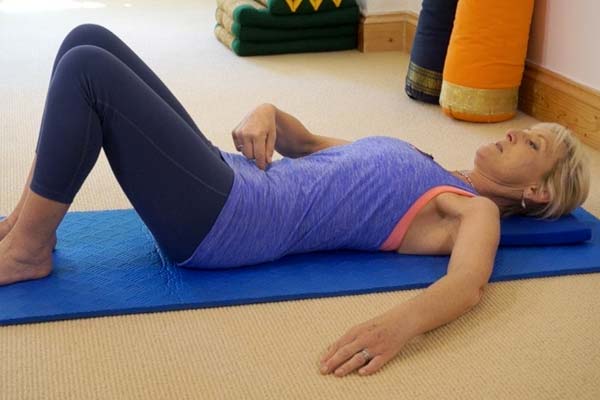
تمرين Pelvic Clocks
تعتبر تمارين Pelvic Clocks واحدة من أكثر التمارين فعالية في برنامج الـ Pilates لمرضى الفيبروميالجيا. تساعد هذه التمارين على تحسين الوعي بالجسم وتعليم الشخص عزل العضلات البطنية والحوضية بينما يحافظ على استرخاء بقية الجسم.
للقيام بهذه التمارين، يجب للشخص أن يستلقي على ظهره مع زوايا الركبتين مرفوعة والقدمين مسنودتين على الأرض. يتم تعليم الشخص كيفية تحريك الحوض بشكل دائري والتركيز على عضلات البطن والحوض.
تساعد تمارين Pelvic Clocks على تحسين الاستقرار الأساسي وتحسين القدرة على التحكم في الحركة والتنسيق. وبالإضافة إلى ذلك، تعمل هذه التمارين على زيادة المرونة في المفاصل والتحكم في الألم وتحسين الحركة العامة للجسم.
يمكن للشخص الذي يعاني من الفيبروميالجيا الاستفادة من هذه التمارين كجزء من برنامج الـ Pilates الخاص بهم لتحسين قدرتهم على الحركة وتقليل الألم.
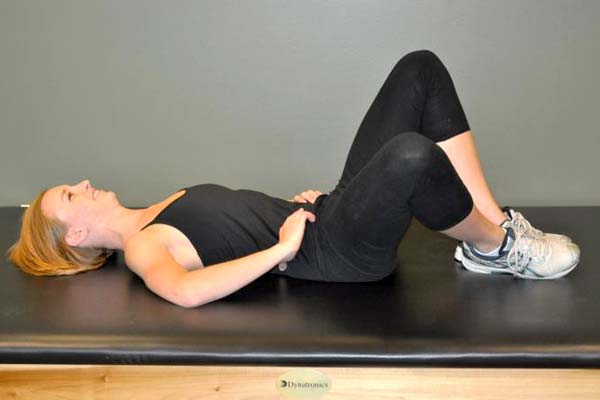
تمرين Bent Knee Fall Outs
تمرين Bent Knee Fall Outs هو تمرين يعمل على تقوية العضلات الأساسية والتي تعتبر مهمة للأشخاص الذين يعانون من الفيبروميالجيا. يعمل هذا التمرين على تقوية العضلات الداخلية للفخذين والجانبية والعضلات الرباعية، كما يساعد على تنشيط الأرضية الحوضية.
تبدأ العضو بالاستلقاء على الأرض مع ركبتيه مثنيتين وقدميه على الأرض، ثم يقوم بسحب الكتفين للأسفل بحيث تكون الكتفين بعيدة عن الأذنين. يتم تحريك الركبتين ببطء للخارج والداخل مع الحفاظ على الأرضية الحوضية ثابتة والعمل بالعضلات الداخلية للفخذين والجانبية والعضلات الرباعية.
تعد هذه الحركة مفيدة لتحسين صحة الظهر والحوض، وتحسين استقرار الحوض وحركية الوركين. يمكن إضافة الأسطح الرغوية والأشرطة المقاومة لجعل هذا التمرين أكثر تحديًا.
يمكن تنفيذ هذا التمرين في أي مكان، ولا يتطلب استخدام أي معدات. يمكن تكرار هذا التمرين حتى 10 مرات في كل جلسة تمرين.
بشكل عام، يعد تمرين Bent Knee Fall Outs من التمارين الفعالة للأشخاص الذين يعانون من الفيبروميالجيا، حيث يعمل على تقوية العضلات وتحسين الاستقرار الحوضي.
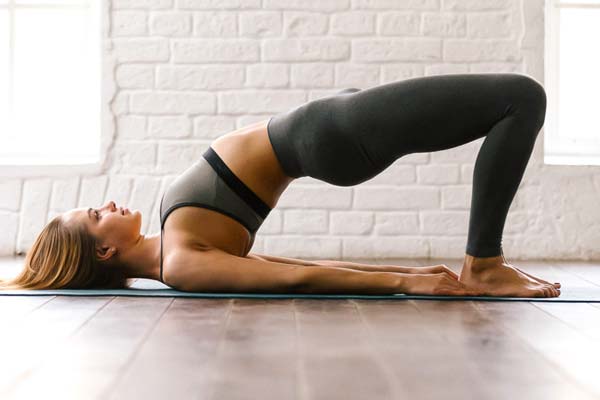
تمرين Bridge
تعتبر تمارين الجسر أحد التمارين الأساسية في برنامج التمارين الخاص بالفيبروميالغيا. يعمل هذا التمرين على تقوية العضلات الأساسية والمؤخرة والفخذين. يساعد هذا التمرين أيضًا في تحسين المرونة في العمود الفقري والحد من تشنجات العضلات.
تعمل تمارين الجسر على تحسين القوة الأساسية ويحتاج المرء إلى قوة أساسية جيدة للقيام بالتمارين الأخرى بشكل صحيح. يعتبر هذا التمرين مفيدًا جدًا لتحسين القوة الأساسية وتقوية العضلات الأساسية.
عند تنفيذ تمارين الجسر، يجب على المرء الاستلقاء على ظهره مع ركبتيه مرفوعتين وقدميه على الأرض. يجب أن تكون الظهر والرقبة مستويين. يتم رفع الوركين من الأرض حتى يصبح الجسم مستقيمًا من الكتفين إلى الركبتين. يجب أن يكون الجسم مستقيمًا والأرداف مشدودة بشكل جيد.
يعتبر تمرين الجسر مفيدًا جدًا لتقوية العضلات الأساسية والمؤخرة والفخذين. يمكن تنفيذ هذا التمرين بشكل متكرر كجزء من برنامج التمارين الخاص بالفيبروميالغيا. يجب تنفيذ التمرين بشكل صحيح وبشكل منتظم للحصول على أفضل النتائج.
لا يوجد شك في أن تمارين الجسر تساعد في تحسين القوة الأساسية وتقوية العضلات الأساسية والمؤخرة والفخذين. لذلك، فإن إضافة هذا التمرين إلى برنامج التمارين الخاص بالفيبروميالغيا يمكن أن يكون مفيدًا جدًا للمرضى.

تمرين Heel Slides
تعاني العديد من الأشخاص المصابين بالفيبروميالغيا من صعوبة في القيام بالتمارين الرياضية الشديدة. ومع ذلك، فإن تمارين البيلاتيس يمكن أن تكون فعالة للغاية في تخفيف الأعراض وتحسين الحركة والمرونة. واحدة من هذه التمارين هي تمرين الانزلاق الكعب.
تشمل هذه التمارين تمديد الساق بعيدًا عن الجسم وثني الركبة وانزلاق الكعب نحو الأرداف. ويمكن تنفيذ هذا التمرين بسهولة في المنزل أو في الصالة الرياضية.
تهدف تمارين الانزلاق الكعب إلى تقوية العضلات المحيطة بالفخذين، مثل العضلات الرباعية والعضلات الهلالية. كما تساعد هذه التمارين على تحسين مدى الحركة والمرونة في المفاصل.
يمكن تنفيذ تمارين الانزلاق الكعب بشكل متكرر لتحقيق أفضل النتائج. ويمكن تعديل هذه التمارين لتناسب مستوى اللياقة البدنية لكل شخص.
بشكل عام، فإن تمارين البيلاتيس يمكن أن تكون مفيدة للغاية للأشخاص المصابين بالفيبروميالغيا. ويمكن أن تساعد هذه التمارين على تحسين الحركة والمرونة وتخفيف الأعراض بشكل عام.
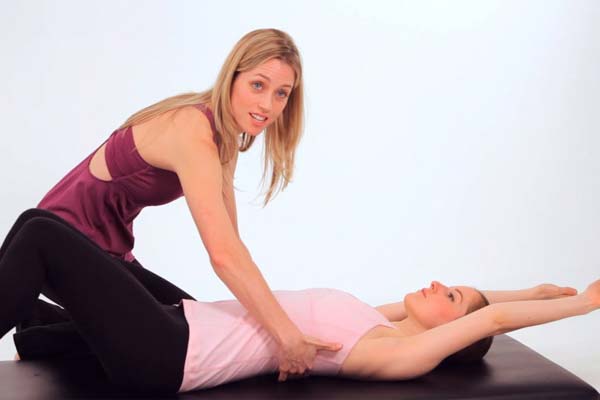
تمرين Ribcage Arms
تعتبر تمارين Ribcage Arms من التمارين الهامة في البيلاتس لمرضى الفيبروميالغيا. تساعد هذه التمارين على تحسين وضعية الجسم والتنفس والتنسيق والتوازن، كما تعمل على تقوية عضلات الصدر والكتفين والظهر.
يتم تنفيذ تمارين Ribcage Arms بالاستلقاء على الظهر وثني الركبتين ووضع القدمين على الأرض. يتم رفع الأذرع باتجاه السقف وثني المرفقين بزاوية 90 درجة. يتم تحريك الأذرع بطريقة دائرية صغيرة باتجاه الأسفل والخلف، ثم الأعلى والأمام. يتم تكرار هذه الحركة لعدة مرات.
تعمل تمارين Ribcage Arms على تحسين وضعية الجسم والتنفس والتنسيق والتوازن، كما تساعد على تقوية عضلات الصدر والكتفين والظهر. كما تساعد هذه التمارين على تحسين التنفس وتدفق الأكسجين إلى الجسم.
تنصح الجمعية الوطنية للفيبروميالغيا بممارسة التمارين الرياضية المناسبة لمرضى الفيبروميالغيا، ويعد البيلاتس من التمارين الآمنة والفعالة لهؤلاء المرضى. يجب الالتزام بتعليمات المدرب والتحدث مع الطبيب قبل بدء أي تمارين.
هل البيلاتس مناسب لك؟
البيلاتس هو نوع من التمارين الرياضية التي تعمل على تقوية العضلات وتحسين المرونة والتوازن وتحسين الصحة العامة. ومن الممكن أن يكون البيلاتس مناسبًا للأشخاص الذين يعانون من فيبروميالغيا (FMS) أو متلازمة الإرهاق المزمن (CFS أو ME / CFS)، ولكن فقط لأولئك الذين يمكنهم تحمل المستوى المناسب من الجهد.
تعتبر البيلاتس مناسبة للأشخاص الذين يفضلون التمارين ذات الأثر الخفيف على الجسم، والتي تعمل على تحسين الصحة العامة واللياقة البدنية. ومن المهم النظر في مستوى اللياقة البدنية الحالي للفرد قبل البدء في ممارسة التمارين الرياضية، وخاصةً إذا كان يعاني من أي مشاكل صحية.
إذا كان الفرد يعاني من القلق أو الاكتئاب، فقد يساعد ممارسة البيلاتس في تحسين حالته النفسية والعقلية. ومن المهم الحديث مع الطبيب المعالج قبل البدء في ممارسة التمارين الرياضية، خاصةً إذا كان يتناول أي أدوية.
يمكن أن يساعد البيلاتس في تحسين الصحة العامة واللياقة البدنية، ولكن يجب ممارسته بتقنية صحيحة. ويمكن أن يساعد الممارسة المنتظمة للبيلاتس في تحسين القدرة على المشي وتحسين المرونة وتقوية العضلات وتحسين التوازن وتقليل آلام الظهر.
ويمكن أن يكون البيلاتس بديلاً جيدًا للتمارين الرياضية الأخرى، مثل رفع الأثقال أو التمارين الهوائية، خاصةً إذا كان الفرد يعاني من مشاكل في العظام أو العضلات أو الأربطة أو الأوتار. ويمكن أن يساعد البيلاتس في تحسين الوعي الجسدي وتقليل التوتر العضلي وتحسين صحة الجهاز الهضمي وتحسين الصحة العامة واللياقة البدنية.
